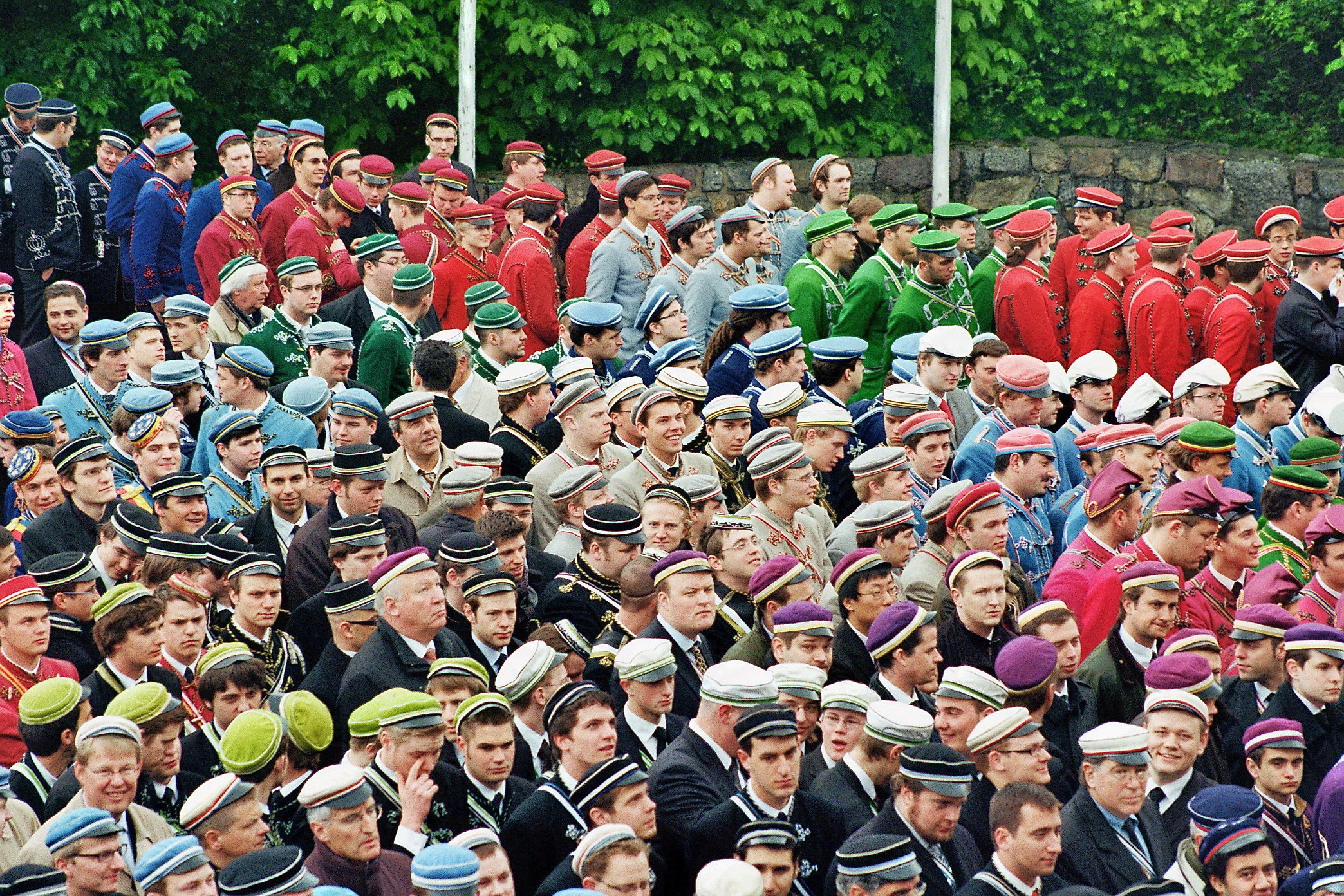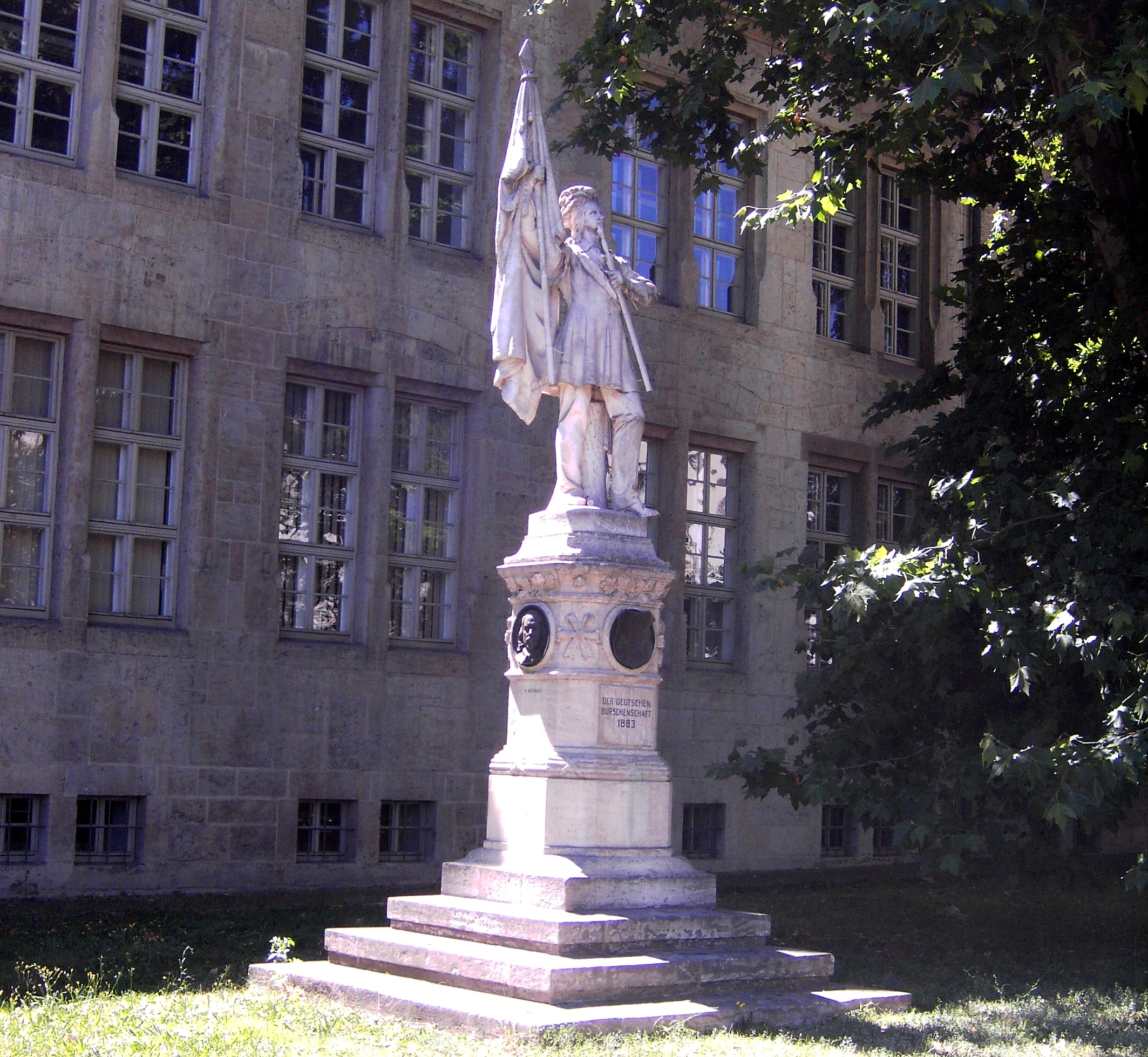|
Burschenschaften
A Burschenschaft (; sometimes abbreviated in the German ''Burschenschaft'' jargon; plural: ) is one of the traditional (student associations) of Germany, Austria, and Chile (the latter due to German cultural influence). Burschenschaften were founded in the 19th century as associations of university students inspired by liberal and nationalistic ideas. They were significantly involved in the March Revolution and the unification of Germany. After the formation of the German Empire in 1871, they faced a crisis, as their main political objective had been realized. So-called were established, but these were dissolved by the Nazi regime in 1935/6. In West Germany, the were re-established in the 1950s, but they faced a renewed crisis in the 1960s and 1970s, as the mainstream political outlook of the German student movement of that period swerved to the radical left. Roughly 160 exist today in Germany, Austria and Chile. History Origins The very first one, called ("original "), ... [...More Info...] [...Related Items...] OR: [Wikipedia] [Google] [Baidu] |
Studentenverbindung
(; often referred to as Verbindung) is the umbrella term for many different kinds of fraternity-type associations in German-speaking countries, including Corps, , , , and Catholic fraternities. Worldwide, there are over 1,600 , about a thousand in Germany, with a total of over 190,000 members. In them, students spend their university years in an organized community, whose members stay connected even after graduation. A goal of this lifelong bond () is to create contacts and friendships over many generations and to facilitate networking. The is very important for the longevity of these networks. Their autonomous and grassroots democratic is also an important similarity of all student corporations. Apart from the and the , every Studentenverbindung also has a so-called (borrowed French for 'how'). The is a body of rules that organize various different aspects of fraternity life such as the , academic fencing (), and general rules of conduct. Fraternities of this particula ... [...More Info...] [...Related Items...] OR: [Wikipedia] [Google] [Baidu] |
German Student Corps
Corps (or Korps; "''das ~''" ('' n''), (''sg.''), (''pl.'')) are the oldest still-existing kind of ''Studentenverbindung'', Germany's traditional university corporations; their roots date back to the 15th century. The oldest corps still existing today was founded in 1789. Its members are referred to as corps students (''Corpsstudenten''). The corps belong to the tradition of student fraternities which wear couleur and practice academic fencing. The corps are organized in two federations, the ''Kösener Senioren-Convents-Verband'' (''KSCV'') and the ''Weinheimer Senioren-Convent'' (''WSC''). Together, they comprise 162 Corps throughout Germany, Austria, Belgium, Estonia, Latvia, Hungary, Switzerland and Lithuania. The German Student Corps were traditionally recruited from the nobility, royalty, and social elite, and are traditionally viewed as more aristocratic and elitist than other German student fraternities such as the Catholic Cartellverband and the Burschenschaften. T ... [...More Info...] [...Related Items...] OR: [Wikipedia] [Google] [Baidu] |
Unification Of Germany
The unification of Germany (, ) was the process of building the modern German nation state with federalism, federal features based on the concept of Lesser Germany (one without multinational Austria), which commenced on 18 August 1866 with adoption of the North German Confederation Treaty establishing the North German Confederation, initially a Kingdom of Prussia, Prussian-dominated military alliance which was subsequently deepened through adoption of the North German Constitution. The process symbolically concluded with the ceremonial proclamation of the German Empire on 18 January 1871 celebrated later as the customary date of the German Empire's foundation, although the legally meaningful events relevant to the accomplishment of unification occured on 1 January 1871 (Constitution of the German Confederation (1871), accession of South German states and constitutional adoption of the name German Empire) and 4 May 1871 (entry into force of the permanent Constitution of the Germ ... [...More Info...] [...Related Items...] OR: [Wikipedia] [Google] [Baidu] |
Urburschenschaft
The Urburschenschaft () was the first ''Burschenschaft'', one traditional form of German student fraternities. It was founded in 1815 in Jena, Thuringia, in Germany. As colours, following their initial use in a state flag by the elder Reuss noble line in 1778 but having no known connections to that event, the ''Urburschenschaft'' adopted Black-Red-Gold, later to become the National colours of Germany. Many founding members of the Jena Burschenschaft had been fighting in the Lützow Free Corps during the Wars of Liberation. The uniforms of the Royal Prussian Free Corps von Lützow were black, with red trim, and golden coloured brass buttons. The Jena ''Urburschenschaft'' had 859 active students as members, about 60 per cent of all the students at the university of Jena from 1815 to 1820. One of its first members was Heinrich von Gagern, the president of the Frankfurt Parliament in 1848/49. At other German universities ''Burschenschaften'' were founded in the early 19th ce ... [...More Info...] [...Related Items...] OR: [Wikipedia] [Google] [Baidu] |
Flag Of Urburschenschaft
A flag is a piece of fabric (most often rectangular or quadrilateral) with a distinctive design and colours. It is used as a symbol, a signalling device, or for decoration. The term ''flag'' is also used to refer to the graphic design employed, and flags have evolved into a general tool for rudimentary signalling and identification, especially in environments where communication is challenging (such as the maritime environment, where semaphore is used). Many flags fall into groups of similar designs called flag families. The study of flags is known as "vexillology" from the Latin , meaning "flag" or "banner". National flags are patriotic symbols with widely varied interpretations that often include strong military associations because of their original and ongoing use for that purpose. Flags are also used in messaging, advertising, or for decorative purposes. Some military units are called "flags" after their use of flags. A ''flag'' (Arabic: ) is equivalent to a brigade in ... [...More Info...] [...Related Items...] OR: [Wikipedia] [Google] [Baidu] |
Lützow Free Corps
Lützow Free Corps ( ) was a volunteer force of the Prussian army during the Napoleonic Wars. It was named after its commander, Ludwig Adolf Wilhelm von Lützow. The Corpsmen were also widely known as the “''Lützower Jäger''“ or “''Schwarze Jäger''“ (“Black Hunters”), sometimes also "Lützower Reiter" ("Lützow Riders"). Origins The unit was officially founded in February 1813 as ''Königlich Preußisches Freikorps von Lützow'' (Royal Prussian Free Corps von Lützow). Lützow, who had been an officer under the ill-fated Ferdinand von Schill, obtained permission from the Prussian Chief-of-Staff Gerhard von Scharnhorst to organize a free corps consisting of infantry, cavalry, and Tyrolean '' Jäger'' (literally, “hunters” ― ''i.e''., marksmen, snipers), for flank attacks and guerrilla warfare behind the French lines. Volunteers were to be drawn from all over Germany (including Austria) to fight against Napoleon I of France; it was hoped that this broadly natio ... [...More Info...] [...Related Items...] OR: [Wikipedia] [Google] [Baidu] |
National Colours Of Germany
The national colours of the Federal Republic of Germany are officially black, red, and gold, defined with the adoption of the West German flag as a tricolour with these colours in 1949. As Germany was divided into West Germany and East Germany beginning in 1949 and continuing through 1990, both Germanies retained the black, red, and gold colors on each respective flag. After German reunification in 1990, West and East Germany adopted the West German flag as the flag of the reunited Germany, therefore maintaining black, red, and gold as Germany's colors. The colours ultimately hark back to the tricolour adopted by the ''Urburschenschaft'' of Jena in 1815, representing an early phase in the development of German nationalism and the idea of a unified German state. Since the 1860s, there has been a competing tradition of national colours as black, white, and red, based on the Hanseatic flags, used as the flag of the North German Confederation and the German Empire. The Weimar Republ ... [...More Info...] [...Related Items...] OR: [Wikipedia] [Google] [Baidu] |
Holy Roman Empire
The Holy Roman Empire was a Polity, political entity in Western Europe, Western, Central Europe, Central, and Southern Europe that developed during the Early Middle Ages and continued until its Dissolution of the Holy Roman Empire, dissolution in 1806 during the Napoleonic Wars. From the accession of Otto I in 962 until the twelfth century, the Empire was the most powerful monarchy in Europe. Andrew Holt characterizes it as "perhaps the most powerful European state of the Middle Ages". The functioning of government depended on the harmonic cooperation (dubbed ''consensual rulership'' by Bernd Schneidmüller) between monarch and vassals but this harmony was disturbed during the Salian Dynasty, Salian period. The empire reached the apex of territorial expansion and power under the House of Hohenstaufen in the mid-thirteenth century, but overextending led to partial collapse. On 25 December 800, Pope Leo III crowned the List of Frankish kings, Frankish king Charlemagne as Carolingi ... [...More Info...] [...Related Items...] OR: [Wikipedia] [Google] [Baidu] |
Norwood, Massachusetts
Norwood is a town and census-designated place in Norfolk County, Massachusetts, United States. Norwood is part of the Greater Boston area. As of the 2020 census, the population was 31,611. The town was named after Norwood, England. Norwood is on the Neponset River, which runs all the way to Boston Harbor from Foxborough. History The Town of Norwood, officially formed in 1833, was until that time part of Dedham, known as the "mother of towns", as fourteen of the present communities of eastern Massachusetts lay within its original borders. Long used as a hunting ground by Native Americans, Norwood was first settled by Ezra Morse in 1678. He set up a sawmill in what is now South Norwood, the part of town to which the first concentration of families, almost all of whom were farmers, migrated over the next half-century. During the American Revolution, there was a Minuteman company organized in the area. Its captain, Aaron Guild, on learning of the British marching on Lexington ... [...More Info...] [...Related Items...] OR: [Wikipedia] [Google] [Baidu] |
Public Domain
The public domain (PD) consists of all the creative work A creative work is a manifestation of creative effort including fine artwork (sculpture, paintings, drawing, sketching, performance art), dance, writing (literature), filmmaking, and composition. Legal definitions Creative works require a cre ... to which no exclusive intellectual property rights apply. Those rights may have expired, been forfeited, expressly waived, or may be inapplicable. Because those rights have expired, anyone can legally use or reference those works without permission. As examples, the works of William Shakespeare, Ludwig van Beethoven, Leonardo da Vinci and Georges Méliès are in the public domain either by virtue of their having been created before copyright existed, or by their copyright term having expired. Some works are not covered by a country's copyright laws, and are therefore in the public domain; for example, in the United States, items excluded from copyright include the for ... [...More Info...] [...Related Items...] OR: [Wikipedia] [Google] [Baidu] |
War Of The Sixth Coalition
In the War of the Sixth Coalition (March 1813 – May 1814), sometimes known in Germany as the Wars of Liberation, a coalition of Austria, Prussia, Russia, Spain, the United Kingdom, Portugal, Sweden, and a number of German States defeated France and drove Napoleon into exile on Elba. After the disastrous French invasion of Russia of 1812 in which they had been forced to support France, Prussia and Austria joined Russia, the United Kingdom, Sweden, and Portugal, and the rebels in Spain who were already at war with France. The War of the Sixth Coalition saw major battles at Lützen, Bautzen, and Dresden. The even larger Battle of Leipzig (also known as the Battle of Nations) was the largest battle in European history before World War I. Ultimately, Napoleon's earlier setbacks in Spain, Portugal and Russia proved to be the seeds of his undoing. With their armies reorganized, the allies drove Napoleon out of Germany in 1813 and invaded France in 1814. The Allies defeated the ... [...More Info...] [...Related Items...] OR: [Wikipedia] [Google] [Baidu] |

.jpg)






